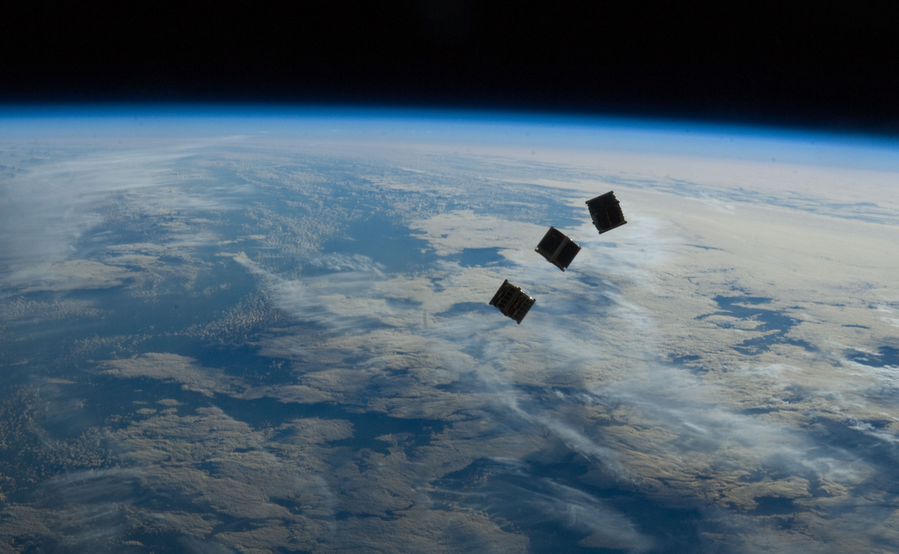(单词翻译:单击)
We humans have become pretty good at sending things to space.
人类已经十分擅长向宇宙发射物体了。
But once a spacecraft is up there, moving it around can be trickier especially if it's tiny.
不过,航天器一旦发射到宇宙中,要让航天器移位就困难多了,而且越小的航天器越难移动。
The fiery rocket launches we know and love involve engines that are just too powerful for something like a toaster-sized CubeSat once it's in space.
我们都很喜欢平时见到的激动人心的火箭发射过程,这其中少不了发动机的作用。但要想让宇宙里烤箱大小的立方体卫星移动的话,用于火箭发射的发动机还是力道太大了。
These little probes and satellites sometimes just need gentle nudges instead of big shoves.
这种小型的探测器和卫星有时候只需要轻轻推动就可以了,不需要大力猛推。
But, unlike traditional rocket engines, these spacecraft do need engines that can keep nudging for years or decades without running out of fuel.
但与传统的火箭发动机不同,航天器所需要的发动机要能持续数年甚至数十年推动他们运动,而且发动机提供动力不需要以燃烧燃料为前提。
And one promising new way of accomplishing that is called electrospray propulsion.
有一种新兴方式很有前景,这种方式叫做电喷发动机。
It nudges spacecraft with tiny, charged droplets, and it's already quietly passed rigorous tests on one of the most sensitive probes we've got.
这种方式通过带电小液滴来提供推力,其可操作性已经在目前为止敏感度最高的探测器上通过了严格的测试。
All rocketry is based on our old friend Isaac Newton's third law of motion, which says that forces always come in pairs.
所有火箭技术的基础都是我们的故友艾萨克·牛顿发现的第三运动定律。该定律指出,力的作用是相互的。
One way or another, fuel gets pushed out of the back of the rocket.
燃料总是要从火箭尾部喷射出去的。
And when the rocket pushes back on the fuel, the fuel also pushes forward on the rocket, so the spacecraft moves.
而当火箭给燃料推力的时候,燃料也会给火箭一个反作用力,这样航天器才能动起来。
That's true whether the rocket uses explosions or squeezes air out of a balloon.
该定律既适用于火箭利用爆炸升空,也适用于气球通过挤出的气体飞起。
Huge, traditional rockets, the kind that get things off the Earth are a lot closer to the explosions side, and use energetic chemical reactions.
传统的火箭体型庞大,可以将物体带离地球表面,这种火箭离爆炸面更近,可以利用化学反应所提供的能量。
But these engines can deliver more power than a lot of tiny probes need,
但这种发动机提供的能量大过许多小型探测器的需要,
and they can go through their fuel faster than we'd like for long-term, low-maintenance missions.
而且它们消耗燃料的速度更快,不是长期的低消耗任务所需要的那种发动机。
This is where electrospray propulsion comes in.
这时候就需要电喷发动机了。
It's a type of ion engine, which uses strong electric fields to push electrically charged atoms called ions out of the back of the ship.
这种发动机是一种离子发动机,它通过强力电场来将带电原子(即电子)从航天器尾部喷出。
These engines can be tiny and efficient. Like, thrusters the size of quarters can work continuously for weeks at a time.
这种发动机体型小巧,效率很高,这种推进器的发动机可以一次性连轴运转数周。
They can do this by providing way smaller forces than chemical engines and go through their fuel a lot more slowly.
它们可以通过提供比化学发动机更小的动力以减慢燃料消耗速度来实现这一点。
And that's perfect for something like a CubeSat, a lightweight, mini-satellite that needs to gather data from orbit for a long time.
这种发动机很适用于立方体卫星这种质量轻、体型小的卫星,这种卫星需要长期在轨道上运转以收集数据。
There are actually a few types of ion engines already, and one was even used for the Dawn mission to the asteroid belt.
实际上已经有几种离子发动机了,而且其中一个甚至已经用于飞往小行星带的黎明号小行星探测器。
But these engines are a little different than electrospray ones.
但离子发动机与电喷发动机有些许不同。
Traditionally, ion engines work by relying on a bunch of individual atoms for thrust.
以前的离子发动机是通过一组单个的原子提供推力来运转的。
The atoms are pushed out the back, and the craft moves forward.
离子从航天器尾部喷发出来之后,航天器就会向前移动。
But electrospray engines use tiny, charged droplets of liquid or groups of atoms for thrust instead.
但电喷发动机是靠带电小液滴(一些原子群)来提供推力的。

Those liquids might be something like molten salts, although engineers are still trying to find the best materials for the job.
这种液滴是类似于熔盐一样的东西,不过科学家还在试图寻找最适合的材料。
Some thrusters might even use mixtures of liquids, which scientists sometimes call a "colloid", so they're also sometimes known as "colloid thrusters".
有的推进器还会用液体混合物,也就是科学家口中的“胶体”,所以这种推进器有时候也称“胶体推进器”。
One major benefit of these engines over other kinds of ion propulsion is that they're a lot easier to control and fine-tune.
与离子推进相比,这种发动机的一个主要优势就是:可操控性更强。
If you only need a little force for your spacecraft, it's a lot easier to create a smaller droplet of liquid than it is to control a bunch of individual atoms.
当航天器需要一丢丢的推力时,产生一个液滴比控制一群单个原子要容易多了。
This kind of control is perfect for some of today's smallest satellites, like CubeSats or the even tinier nanosatellites,
这种控制原理对于当今的一些最小的卫星(比如立方体卫星甚至是更小的纳卫星)来说是再合适不过的了,
which usually don't have any propulsion systems of their own.
因为这些小型卫星通常没有自己的推进系统。
Usually, they just stay in space until the atmosphere drags them back down.
它们通常情况下会一直待在宇宙里,直到大气层将它们拖拽回地球。
But as methods like electrospray become cheaper, easier, and more widespread, we'll start seeing CubeSats that can stay in space almost indefinitely.
但是由于电喷推进器的成本越来越低,操作越来越简单,流行度越来越高,所以我们也会关注立方体卫星可以通过电喷推进器的支持在宇宙里待多久。
And the good news is, research into these engines has recently picked up.
好消息是:最近对于电喷推进器的研究越来越多了。
Because as people have started imagining the kinds of things we could do with a lot of small, inexpensive,
因为人们越是设想用价格低廉、体型小巧的环地球卫星去做一些事情的时候,
Earth-orbiting satellites, electrospray propulsion has seemed even more important.
就越来越意识到电喷推进器方式的重要性。
Like, with a bunch of satellites like this, you could have internet access or phone signals everywhere on Earth.
打个比方,如果能有许多这样的卫星,人类就能在地球的各个角落实现互联网接入和手机信号接入。
Governments would also have an easier time monitoring things like nuclear arms treaties,
政府也将能减小监察核武器条约等问题的难度,
and scientists would have an easier time tracking something like climate change.
科学家追踪气候变化的难度也将下降。
And, of course, fleets of small, exquisitely sensitive satellites and probes would help astronomers, too.
当然,许多外形小巧、精密敏感的卫星和探测器也能帮助天文学家进行研究。
We might not even have to wait very long before this technology is ready to go.
不久后,这种技术就可以投入使用了。
The European Space Agency's LISA Pathfinder probe tested electrospray engines between 2015 and 2017.
欧洲航天局(LISA)的探测者号探测器曾于2015-2017年间对电喷发动机进行了测试。
LISA was a proof-of-concept for a planned team of probes that will hopefully search for gravitational waves,
欧洲航天局曾计划对一组探测器进行概念验证,这些探测器将有希望搜寻引力波
ripples in space caused by super-dense objects moving around.
由移动的超密物体在宇宙中引发的涟漪。
Gravitational waves are unimaginably tiny, so probes looking for them will have to be super sensitive to have any shot at success.
由于引力波小到难以想象,所以搜寻引力波的探测器必须极为敏感,抓住一切成功的可能。
LISA's engines and other stabilizers had to be able to move or turn the ship
欧洲航天局的发动机等平衡器必须能轻微移动航天器,
by the width of a single strand of DNA and then stop without jolting and they needed to keep that precision up for hours or even days at a time.
并确保在停下时不会引起震动,这种精确度要持续数小时甚至数天之久。
And with eight electrospray engines on board, LISA achieved all of its ridiculously precise goals.
而因为欧洲航天局现在已经有了八个电喷发动机,所以许多对精确度要求很高的目标,它都不可思议地实现了。
Now, electrospray engines won't suddenly become the only engine out there.
如今,虽然电喷发动机不会突然变成唯一的顶梁柱,
We'll still need bigger engines to get satellites off of Earth, and to push around larger spacecraft.
不过我们还是需要更大一点的发动机来帮助卫星脱离轨道从而回到地球,或者为更大一点的航天器提供推力。
But as they're improved and refined over the next decade or two,
但是未来的十年至二十年里,发动机会不断改进完善,
we'll probably see them on a lot more of the Earth-orbiting satellites and space-based observatories that make our lives easier.
会有更多的地球卫星甚至宇宙里的天文台是通过现有发动机的改进版来提供推力的,这样人类的生活会更加便捷。
So hopefully we'll have a lot more to say about them soon. Thanks for watching this episode of SciShow Space!
所以,希望不久后,我们能对发动机有更多的研究,感谢收看本期的《太空科学秀》!
If you'd like to learn about another kind of experimental engine,
如果你对另一种还在实验中的发动机感兴趣的话
one that could get humans to Mars in just over a month, you can watch our episode all about the VASIMR engine.
这种发动机可以用一个月多一点的时间将人类送到火星,可以观看我们关于等离子体火箭发动机的那集。


